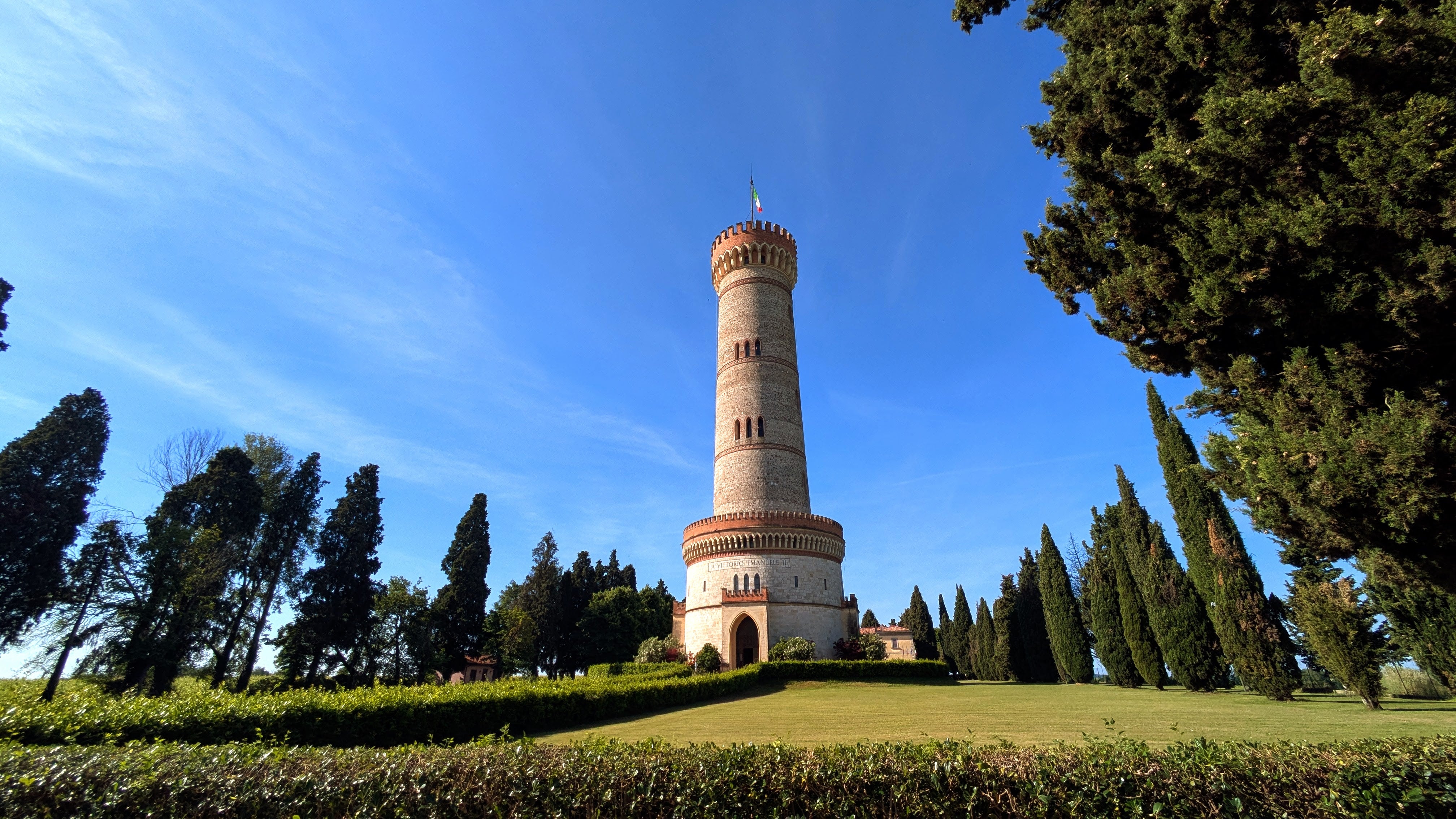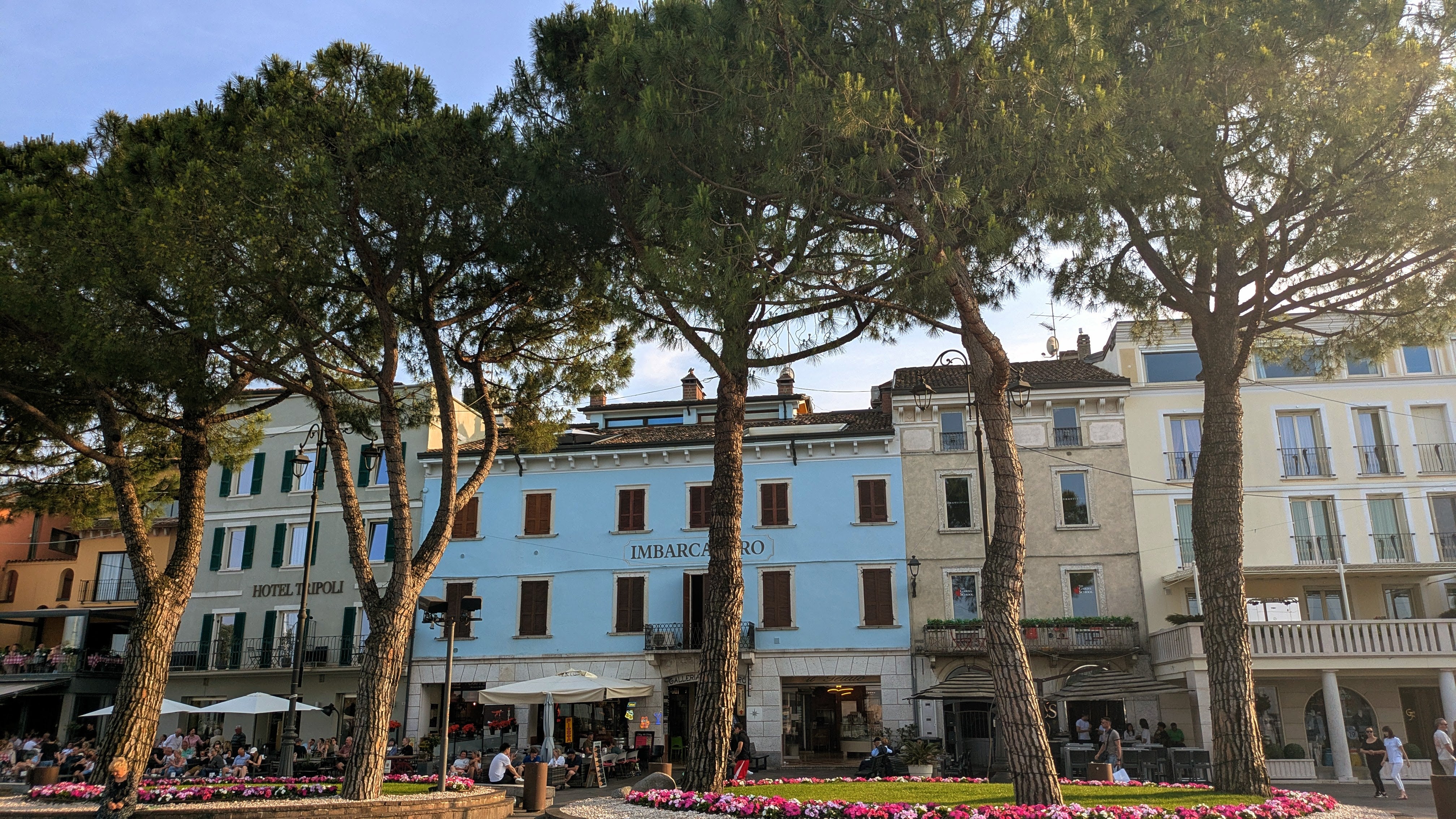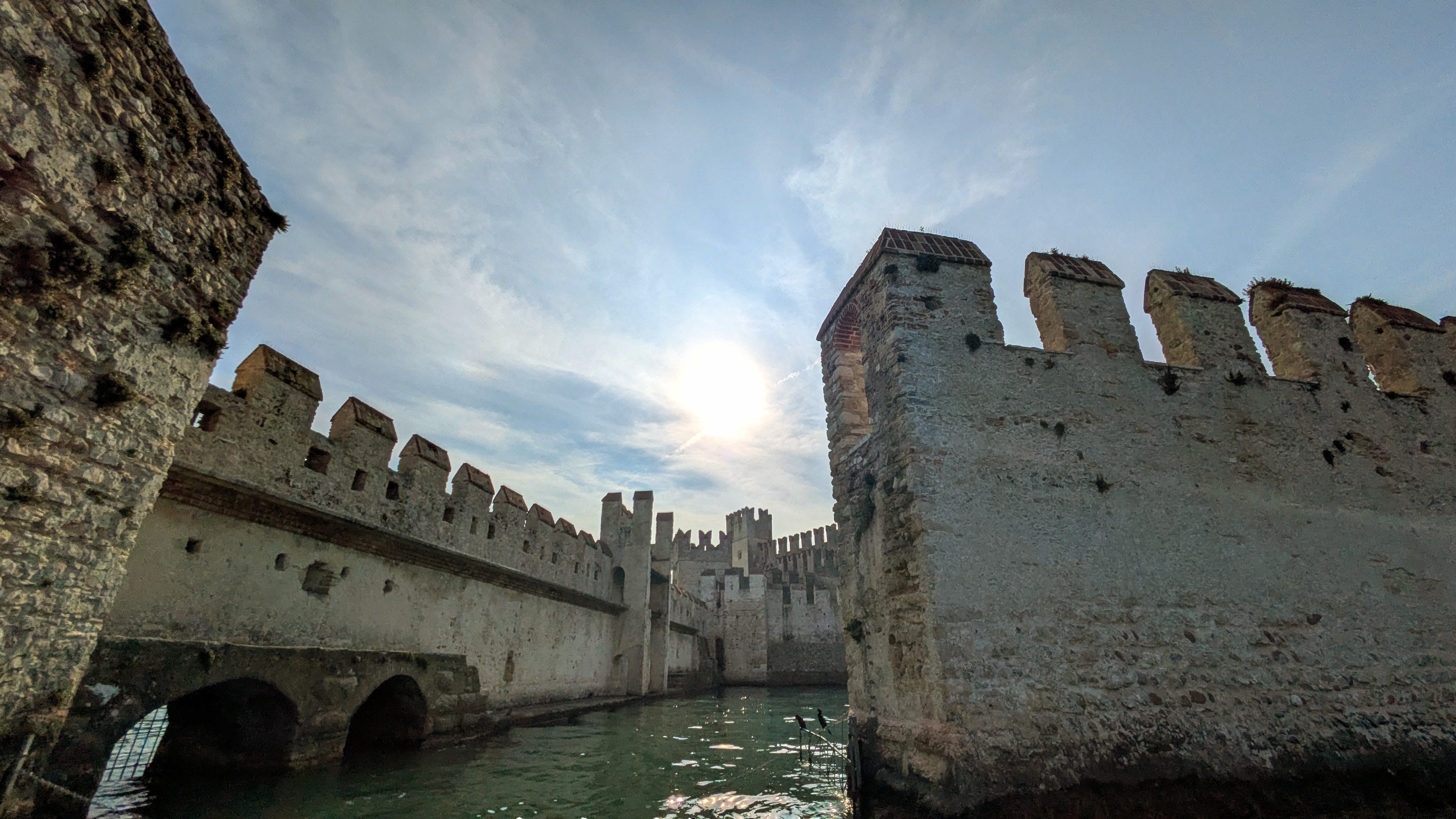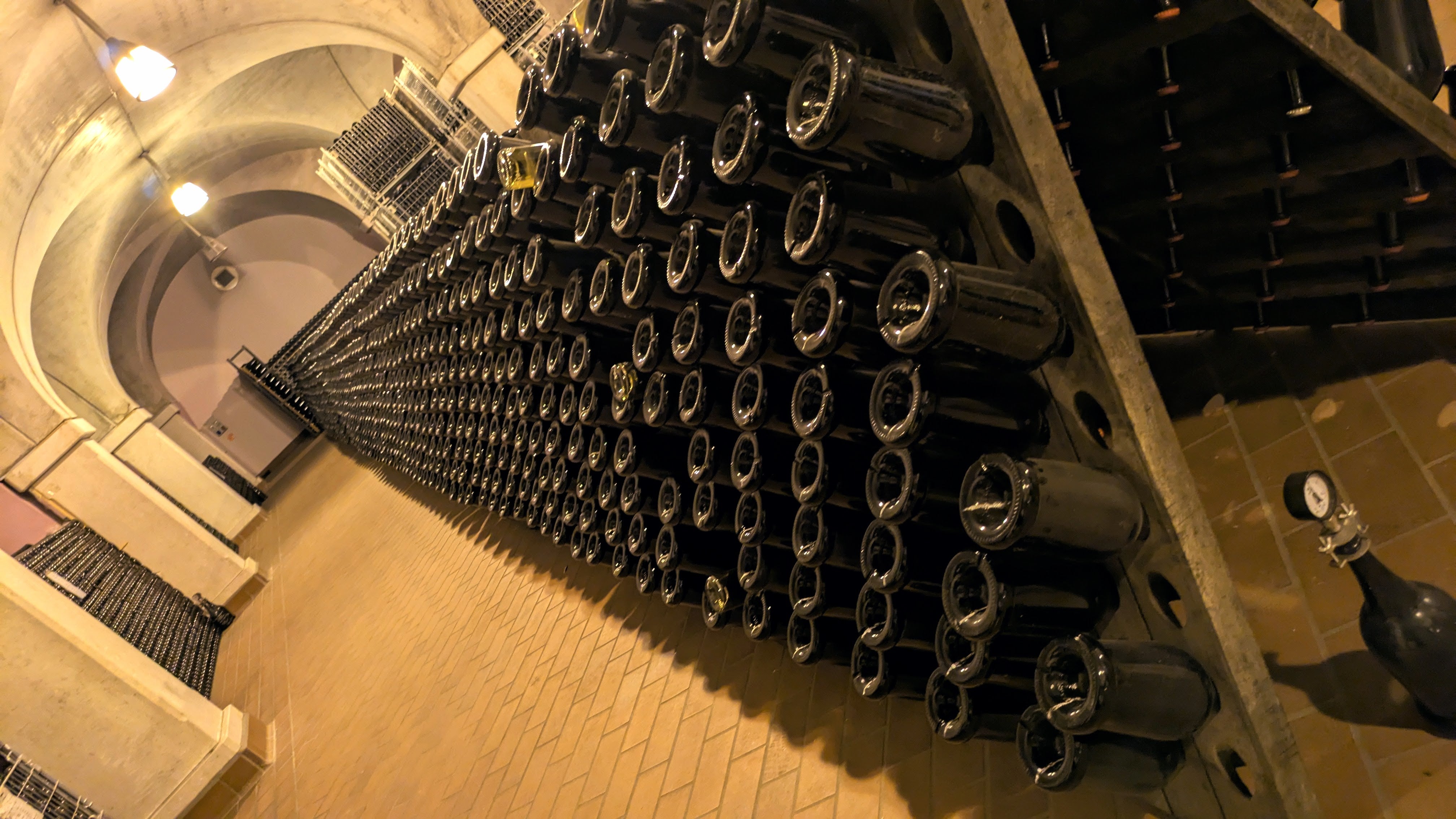“Would you like some music?” Asked Gianluca with a glint in his eye. He was the dazzlingly charming captain of Ghibli, our elegant peppermint leather-upholstered boat which oozed riviera chic. We were halfway through a dreamy tour around the southern end of Lake Garda. Having cruised past Jamaica Beach and the Grottoes of Catullus, the remains of a Roman fort on the tip of the peninsular, we were now approaching the Castello Scaligero di Sirmione, a fortress built by the Venetian Della Scala family at the end of the 14th century. While you can access it by land through its gates of the historic town of Sirmione, it’s also a spectacular sight from the water. It was just us bobbing, along with a handful of cormorants perched on the Venetian wooden “bricole” mooring posts, marvelling at the architectural engineering.
Reaching for the dial on the chrome and walnut veneered dash board on the boat, Gianluca pressed play on a rousing rendition of Nessen Dorma, sung of course, by the maestro Pavarotti. Somehow, none of us flinched as the notes drifted over the diamond-dappled waters in the long afternoon sun. After all, we were living la dolce vita.
Read more: This laidback wine region is Italy’s affordable answer to Champagne
Lake Garda, Italy’s largest lake, sits at the centre of a triangle of three regions: Veneto, Trentino and Lombardy. Cruising around the lake on that sunny Thursday evening gave me the best opportunity to understand the unique landscape that has had such an impact on the wines of this region. I was on an immersive experience, discovering the wines of Lugana DOC (Denominazione di Origine Controllata, an Italian certification of wine which indicates a guarantee of quality). The wine region of Lugana sits across both Veneto and Lombardy, and is often overshadowed by its more famous wine neighbours of Soave and Valpolicella. But, like all the quiet ones, they really do have something very special to say.
You’ll find the vineyards at the southerly end of the lake. While altitude and elevation are often characteristic of quality, here on the low lying land surrounding Lake Garda the finesse of the wines comes through a different story. The unique soils of the region are a result of a huge glacier that carved its ways through the Brenta Dolomites, cutting through the valley. As this glacier gouged its way along, it ground up loose magnesium-rich limestone that was then deposited as moraine along the sides of the ice. The glacier melted, forming Lake Garda, leaving rich, fertile soils. There is also a unique microclimate on the lake; olives and lemons grown in abundance here, with the temperate breezes from the lake creating conditions that allow for long ripening seasons for the grapes.

Read more: The UK’s first wine trail is as good as any in Napa Valley
Lugana produces exclusively white wines from the indigenous Turbiano grape – a versatile variety related to verdicchio, with outstanding acidity, making it incredibly flexible to make a range of different styles. My first taste of this breadth of potential was a glass of Metodo Classico 36 mesi at La Morette winery, a traditional method sparkling wine (made in the same way as Champagne and crémants). It is a gorgeously persistent wine full of aromas of almond croissants and orange blossom with mouthwatering, racy acidity – a characteristic that seemed to be at the core of everything I tasted.
These are wines that uplift and invigorate you. They have tension and energy whether you’re enjoying an easy-breezy entry level Lugana DOC, which is all about the vitality of the recent vintage but with assurance of quality, or something that is aged and more decadent such as Superiore or Classico. Even the limited production vendemia tardive (late harvest dessert wine) leave you with a glorious mouth-watering finish, as I found while tasting one at Cantina Perla del Garda. I felt like I’d discovered a wonderful wine secret, and it was all so easily accessible from the shores of Lake Garda.

I was staying in the bustling town of Desanzano del Garda on the southwestern edge of the lake, its waterfront location offering expansive views of the water, with the rise of the snow-peaked mountains of the Dolomites in the far distance. The town centres around Piazza Malvezzi and the ancient harbour with its opulent 16th-century palaces designed by the Brescian architect Todeschini. The ochre, sky blue and butter-yellow buildings provide a backdrop to a town that’s brimming with life, even on an out of season Wednesday evening. Families, young and old were enjoying their passeggiata, and restaurants were buzzing with people coming together over good food and, of course, great wine.
We’d enjoyed an evening of fine dining at MOS, run by the precociously talented Stefano Zinni who has revitalised an old trattoria located by the marina. Plates of his beautiful cooking included tinca risotto featuring tench caught directly from the lake, paired wonderfully with eminently food-friendly wines of Lugana.
The welcome from winemakers is often unparalleled in Italy, and here was no exception. From the farmhouse tasting room of the brother and sister winemaking duo of Alessandro and Laura at Marangona, to the father and son warmth at the jaw-dropping Cantina Ottella. Despite the high gloss of the winery (it has something of the Bond villain lair about it, in a good way), you feel the connection of the youngest generation to the people who deeply established Lugana as a region in the 1960s. Combining the pride in the legacy and the vision for the future, there is a feeling among the talented producers of this stunning region that is as energetic as the wines themselves.
Read more: The affordable European region with wine loved by the royals

Where to visit
Cantina Ottella: Perhaps one of the most striking wineries I’ve visited, not for its imposing architecture, or landscape, but for the immersive experience in the winery itself. Here, the family ethos is that art, beauty and wine are intrinsically connected, and are woven seamlessly into the fabric of the building. You’ll discover not only a portfolio of beautiful wines, but a striking collection of sculptures and paintings, which are as much a part of the winery as the equipment and barrels they sit alongside. Winery tours are available along with tastings in their spacious and elegant shop and tasting room.
Citari: A visit to this tranquil vineyard should start with ascending the tower of San Martino della Battaglia, an impressive monument to the Battle of Solferino, out of whose tragedy led to the unification of Italy, and also gave birth to the Red Cross. Don’t like steps? Don’t worry, you ascend via a gentle ramp up the inside of the tower which depicts the plight of soldiers on both sides of the battle. The views from the top are expansive, and breathtaking not solely because of the climb.
From there, take a short stroll to Cantina Citari, and enjoy one of their easily bookable wine experiences. It’s a restful spot to enjoy the hospitality of this third generation winery and the elegant, expressive wines. If you’re feeling peckish, why not time your visit with a meal at Agriturismo Ortaglia di Marotti Daniela, a simple restaurant preparing outstanding homemade pasta. Citari is easily accessible by car (15 mins) or bus (30 mins) from Desenzano del Garda.

Perla del Garda: A family-run estate that has revitalised wine production in their corner of Lugana DOC and is creating some remarkable wines that span the full spectrum of the capabilities of Lugana. The sparkling wines, all hand riddled in the traditional method, show great complexity and are truly age-worthy. Wine tours and tastings can be booked and enjoyed throughout the majority of the year.
How to get there
Airlines including British Airways, easyJet and Jet2 operate daily flights to Bergamo Milan or Verona. There is a regular train from Verona to Desenzano del Garda, Sirmione and Peschiera del Garda, all of which are good places to stay to explore the vineyards. Car hire starts from £17 per day.
Rosamund travelled with support from the Consorzio Lugana.
Read more: Inside Europe’s cheap foodie haven with £2 wine and low-cost food

